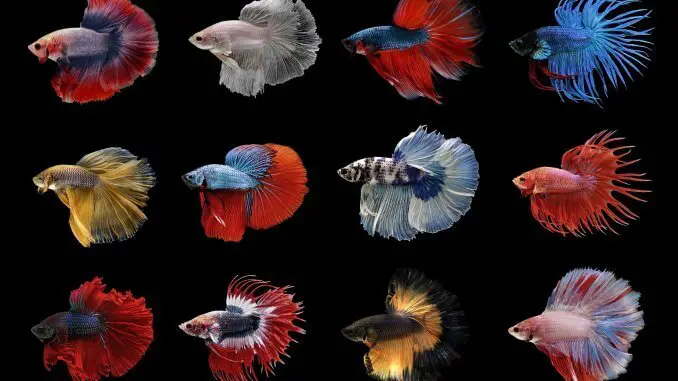
Betta fish are among the most popular freshwater fish around. They are so well-loved due to the many different shapes and colors which they can be found in.
There are so many variations that betta fish are usually classified by their colors, patterns, and tail type.
Their aggressive behavior is often off-putting for newcomers to the hobby. However if properly fed and cared for, you shouldn’t have any problems.
In this article we will discuss all the different variations, to help you find the best fish for you.
TABLE OF CONTENTS
Types of Betta Fish
Betta fish, also known as Siamese fighting fish, are very common with beginner aquarists. They are small and colorful fish with striking personalities.
They have been cross-bred over years creating the most amazing colorations and tail variations.
They do not require a lot of maintenance and their physiology and behavior are quite captivating and amazing.
This fish can learn to recognize their owners, and they also create bubble nests. Betta fish have an organ known as the labyrinth organ which allows them to breathe air as their gills cannot always get enough oxygen from the surrounding waters.
There are different ways to classify Bettas by looking at the shape of their tails, their patterns, and finally colors.
Tails can have a lot of variation, from long and flowing to short and neat. Body patterns can also have lots of variation, from multi-colored patterns to single body patterns.
However, it’s their color that is the most striking characteristic. Betta fish have been bred in all the colors of the rainbow.
When you combine all the different tail shapes, colors, and patterns, there are hundreds of different Betta types available and no one fish is the same.
Tail Types
The tail is one of the most appealing characteristics of all the different betta variations.
Your betta fish will often be classified by the shape and the size of its tail. From short and spiky to large and majestic, you will find all kinds of tail variations full of striking colors.
The different names usually give you an idea of the tail shape, from the most common such as veiltail, crowntail, and halfmoon.
There are many types and coloration you just have to find the one you prefer the most.
Crowntail Betta
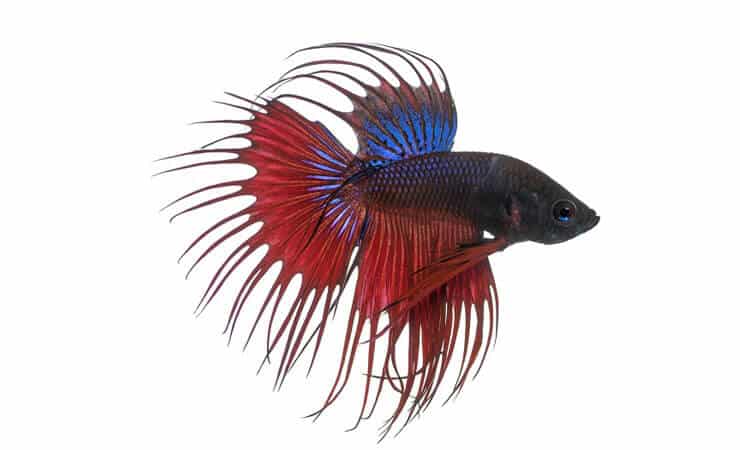
The crowntail betta is one of the most popular freshwater fish. This species is relatively young, first bred by Ahmad Yusuf in Indonesia around 25 years ago.
The fins of this species have a long spikey crown appearance, however, if the webbing reaches more than 2/3 up the tail then it is classified as a different type – the Combtail Betta.
While the males show striking colors with long fins and tails, females look quite different.
Usually, the female has lighter colors with a shorter tail with a less majestic overall appearance.
Veiltail Betta
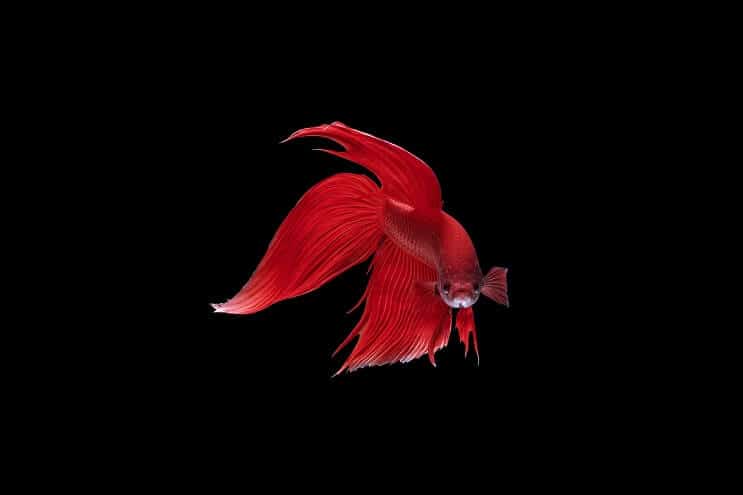
This is another very common variation of the tail type which is widely available.
The male of this variation has a long, flowing downwards swooping tail. It comes in many different color variations and the overall appearance is quite remarkable.
If you want to breed Betta fish, you should know this is a dominant tail type over other variations, and therefore is one of the easiest to breed.
The female is again quite different. She does not have any of the remarkable characteristics of the male but sometimes has bright colors. Females tend to have lighter colorations and short fins and tails.
Plakat Betta
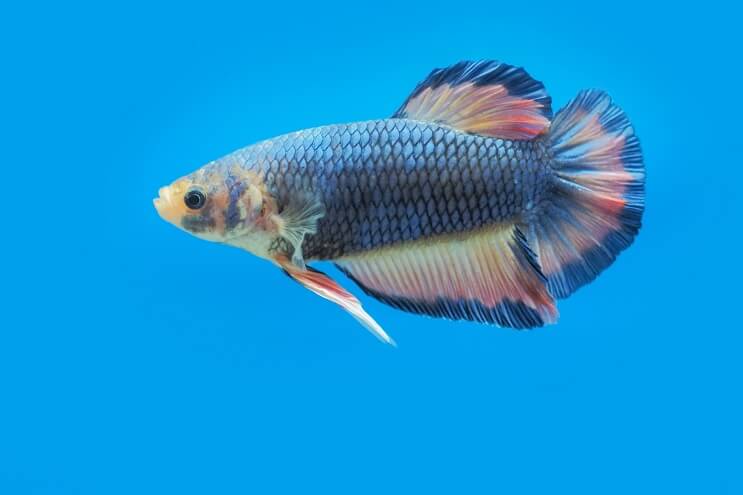
Contrary to most betta fish, plakat bettas have short and round tails. They are almost the exception to the rule. Their fins are also quite short when compared to other variations. Still, the male shows amazing colors.
This betta type is considered the traditional form that would have been found in the wild.
The name plakat derives from the Thai word “plakad” meaning fighting fish. These fish were commonly used and bred for fighting.
Halfmoon Betta
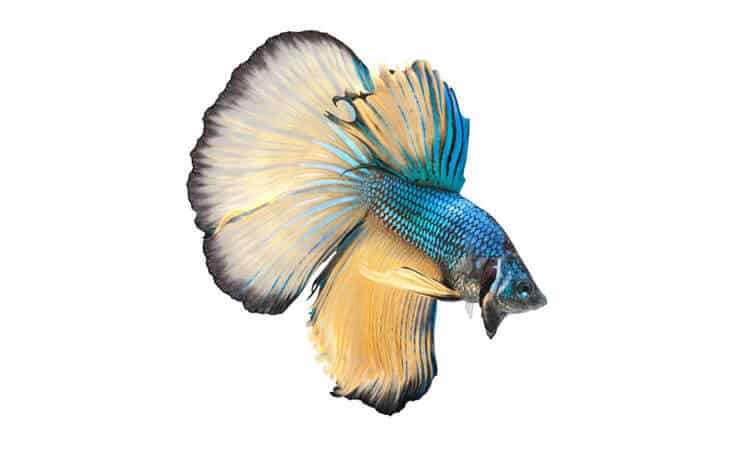
The name Halfmoon Betta is quite self-explanatory. The tail is large creating half a circle similar to the shape of a half-moon.
This type is strictly bred in captivity, you won’t find them in the wild.
Halfmoon Bettas are commonly bred among experts to exhibit during Betta shows. First bred in the 1980s, the Halfmoon Betta didn’t take long to reach Europe and then became internationally famous.
These fish can be a bit challenging to breed and come with more aggressive behavior.
Double Tail Betta
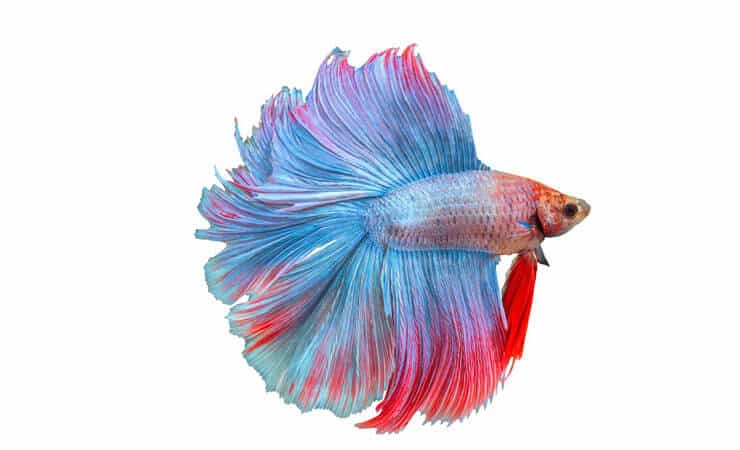
The Double Tail is easily recognizable as it has two distinct tails separated from the base. Usually, this variation has a larger and longer dorsal fin with a shorter body.
This gene can be found in any Betta, of any tail shape and size.
This often means that single tail Bettas already show double tail characteristics such as dorsal fins with more rays than normal which give them a richer appearance.
Elephant Ear Betta/Dumbo Betta
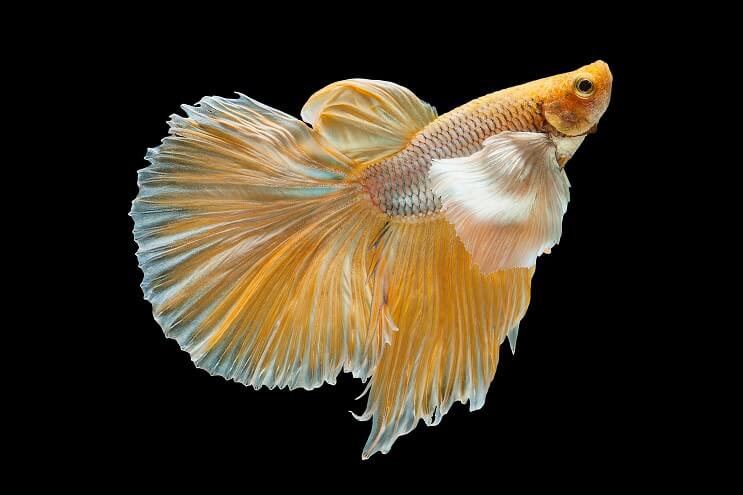
This is a very unique fish that doesn’t really fit into the tail or color category. Instead, its unique feature is its pectoral fins.
Elephant Ear Bettas or more commonly Dumbo Bettas, have quite a unique shape. Usually, with brilliant striking colorations, the fins of this variation are quite funny.
The name is given by the two pectoral fins resembling the ears of an elephant.
These are also found in the wild exhibiting more dull coloration from dark green, grey, and brown. Among the aquarium trade, more striking colors are found such as bright blue, turquoise, red and yellow.
Delta Tail Betta
The Delta Tail Betta has a rather large tail. It is named after the Greek letter d as the tail resembles the shape of the letter delta (∆). The tail starts to narrow towards the body and it widens toward the edges resembling the triangular shape of the Greek letter.
There is also another known variation called the Super Delta. This variation almost reaches 180 degrees flare.
The spread of a normal delta tail is usually much smaller. The tail edges are uniform without any combing or crowing.
Rosetail Betta
The Rosetail Betta is a variation of the half-moon where the total spread of the caudal fin is larger than 180°.
The feature of this variation is that the rays of the tail are particularly branchy. This branching gives a striking look to the fish and makes the caudal fin looking like a rose.
If the tail becomes particularly branchy with a very ruffled appearance then it’s considered a Feathertail.
Other Tail Types
More tail types include the Combtail Betta, Round Tail, Spade Tail, Over-Halfmoon, Super Delta, Half-Sun, and Feathertail.
- Combtail Bettas are similar to Crowntails. The difference is in the length of the webbing and the rays. Combtails have webbing which reaches more than 2/3 of the way up the tail.
- Roundtail Bettas are very similar to Deltas with the difference being the shape of the tail edges. Roundtails have fully rounded tail edges.
- Spade tails take their name from the spade of a deck of cards as the shape of the tail perfectly resembles this round and pointy shape.
- The Over Halfmoon is an extreme version of a Half Moon. The spread of the tail reaches over 180° around the body.
- The Half-Sun was created by selectively breeding Half Moons and Crowntails. Reaching over 180° around the body, the tail and fins also have a slightly crowning among rays and webbing.
Colors
Some Betta Fish might have a uniform color whereas others will be a mix of lots of different colors.
They can be most colors of the rainbow, some will be black, white, electric blue, translucent skin, copper, green and more.
Blue Betta Fish
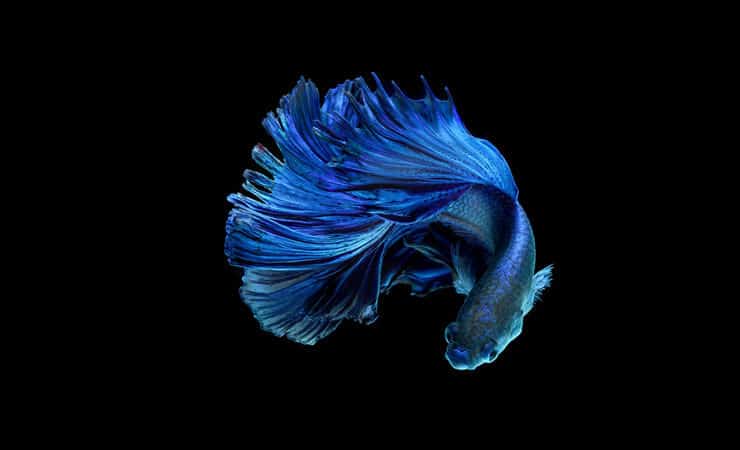
You might think that choosing a blue betta fish is really simple, but this is not always the case. There are many different shades of blue around.
The most common colors are Steel Blue (almost grayish which gives the fish a cold coloration) and the Royal Blue Betta, which is a vibrant and gorgeous coloration showing an iridescent bright blue.
Black Orchid Betta
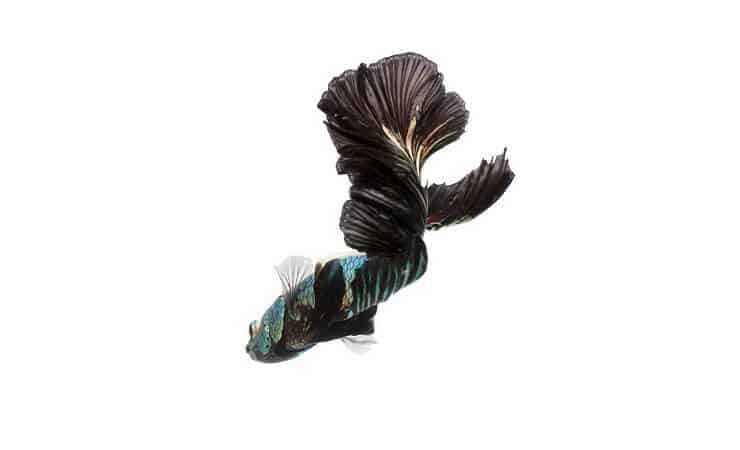
The black orchid betta fish variation has a dark overall coloration. Occasionally you might observe purple or blue highlights along its body.
An interesting fact about the black variation is that this group can be divided into three different types, Melano, Black Lace, and Metallic.
The Black Metallic has iridescent scales almost like the color of copper and translucent.
Red Betta Fish
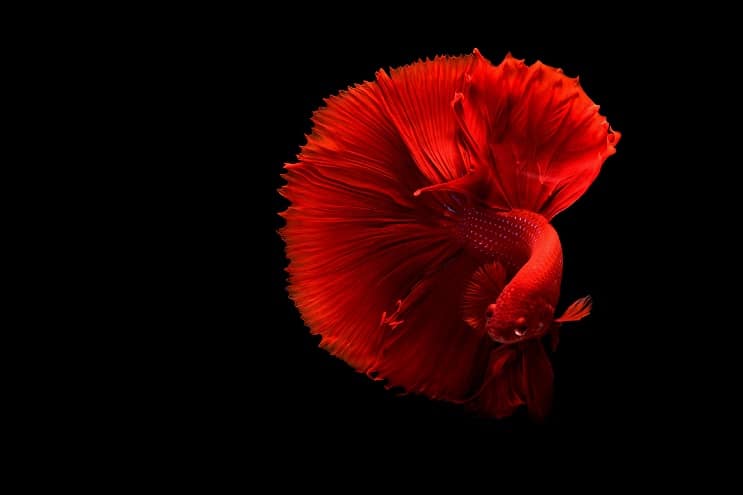
Red is the dominant color with Betta Fish.
Usually appearing as a striking and full-bodied red color, sometimes this red can appear washed off too. On this occasion, you should watch their diet and water condition as your fish might not be feeling at ease.
From Plakat to Veiltail, this color is commonly found across most variations of Bettas.
If it doesn’t appear as one of the dominant colors, it also often shows as a highlight across the fins or the body of other colored fish.
Pink Betta Fish
The Pink Betta Fish can sometimes appear almost translucent.
Transparent-looking Bettas often get confused with the albino variation. These fish have almost no pigment with the flesh shining through the skin.
If the color pink is fuller, the fish will have a bright and rich pink color on their body and fins. However, is not always this simple and even though the overall color is pink, they will probably have more color variations, from red to purple and white along their fins, tail, and body.
Rose Petal Betta
The Rose Petal Betta Fish is perhaps one of the strangest types as there is no one way to define them.
They come in the most color variations, generally electric light blue with some color variations (generally dark blue, copper) and have a darker face.
They are one of the rarest Betta Fish.
Yellow Betta Fish
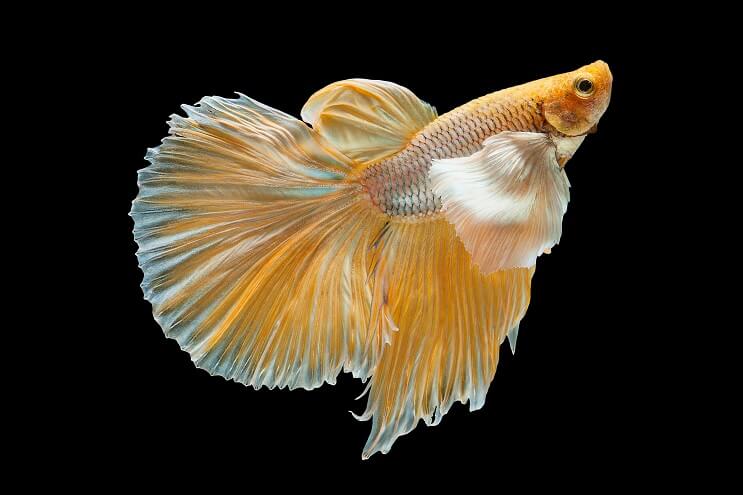
Yellow Betta Fish are also a very common color found. This fish generally shows a full rich body yellow coloration extending along the fins and tail.
This variation can have many different yellow shadings, from extremely yellow to a more tamed soft coloration.
This variation is also known as “non-red” as they exhibit similar characteristics but are yellow.
White Betta Fish
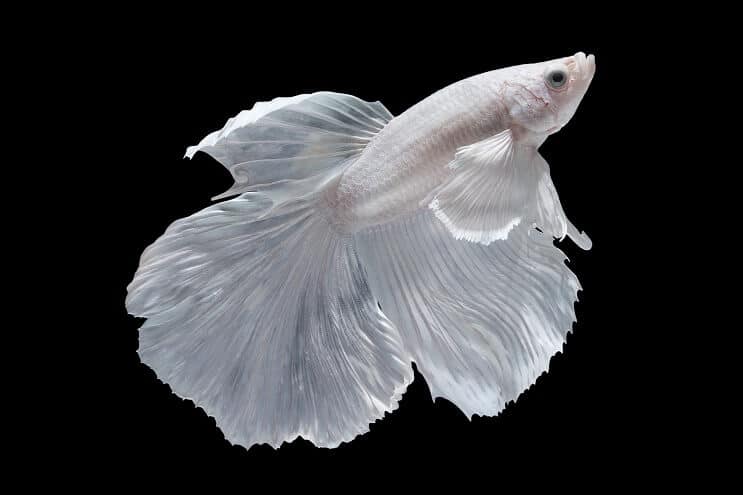
The White Betta Fish might appear a bit plain when compared to other color variations.
These Bettas are completely white. However even though the coloration can appear a bit dull, if you choose the right tail type, they are quite majestic.
You can combine coloration and tail type to find the best for you. Long flowing swooping tails are quite majestic even though completely white.
Purple Betta Fish
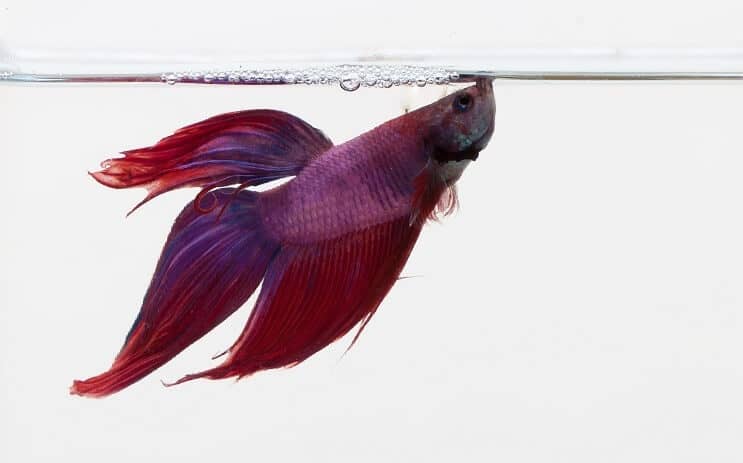
True purple Betta Fish are quite difficult to find.
You will often find them in rich violets or purple-blueish with other color variations such as copper and black. It’s often common to find them with purple bodies and the fins or the face another color.
They have all types of tail types and color patterns. You will just have to find the one that best suits your taste!
Green Betta Fish
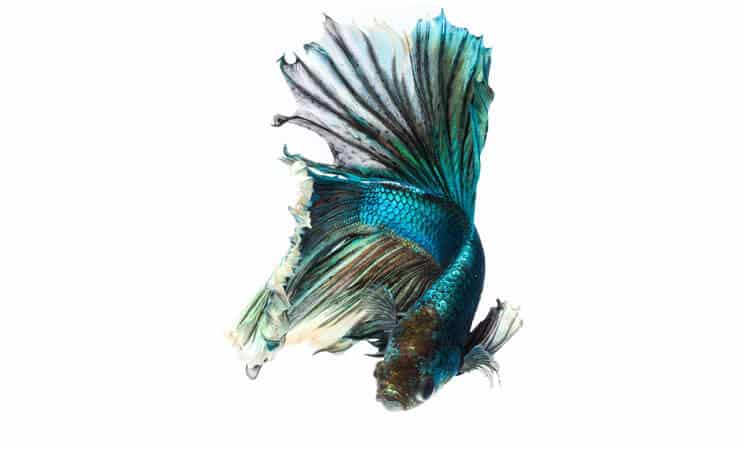
Full green Betta Fish are quite rare. Most commonly they appear as turquoise.
Often the green is masked under a darker coloration, and if you shine light against it an iridescent green tone can appear.
Bright green and dark green variations which are visible with the naked eye do exist but are very rare and often considered very precious.
Mustard Gas Betta
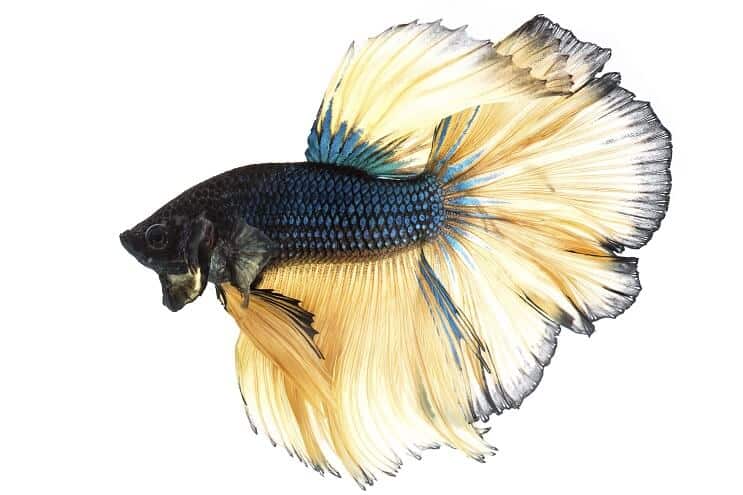
Mustard Gas Betta Fish are quite remarkable. They are a bi-colored variation showing different colorations between body and fins.
The body is dark usually varying from either blue or green. Their fins are usually yellow or orange hence their name.
This variation is often mistakenly called Chocolate as the color of the fins are quite similar. However, the chocolate variation has a brown body.
Patterns
The last way to classify the different types of Betta Fish is through their pattern.
Colors can be arranged in different patterns on their body and fins which make this fish so remarkable and appreciated across the fishkeeping community.
Some of the color patterns have been carefully selected over the years by selective breeding.
Dragon Scale Betta
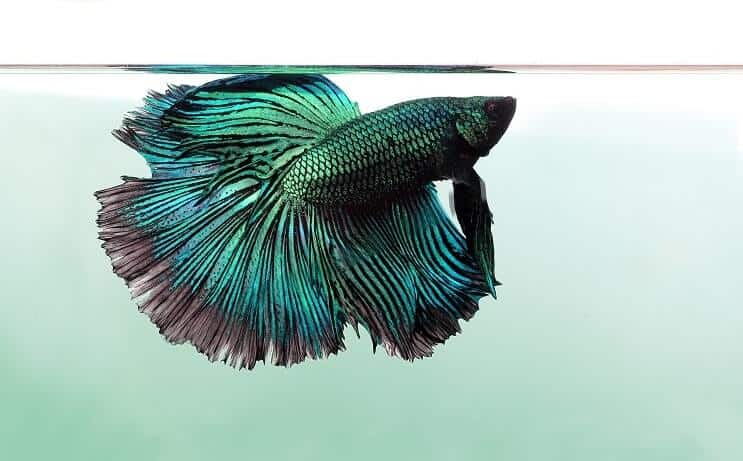
This is a relatively new pattern created through selective breeding. This pattern is very popular for its bright metallic coloration.
The Dragon Scale Betta Fish has a strong full-bodied color with body scales resembling those of a lizard or a dragon.
Their base body color is usually a rich color such as red with iridescent pale scales across its main body (often copper in color).
Butterfly Betta
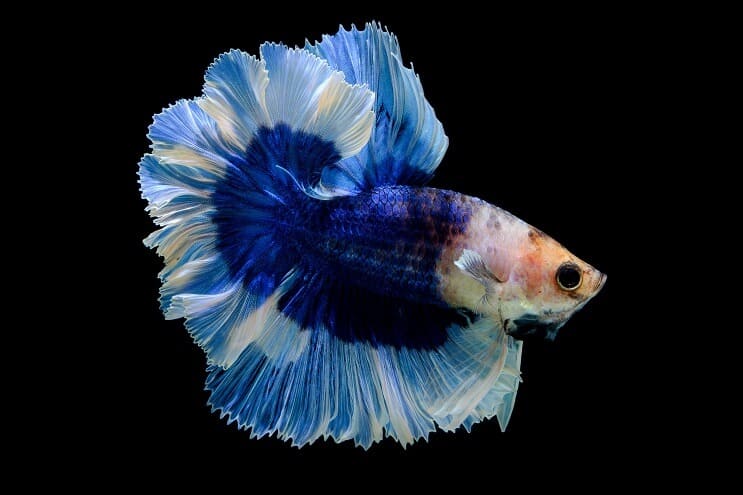
The Butterfly Betta is another common pattern and fairly distinctive.
Typically, it has a solid body color that extends to the base of the fins and tail. This color suddenly stops and is replaced by a paler and iridescent color. Usually the fins and tail are white or transparent.
Another variation of this pattern is to have the body of one color and then the inside of the fins and tail of another to then become white or transparent around the edges.
Marble Betta
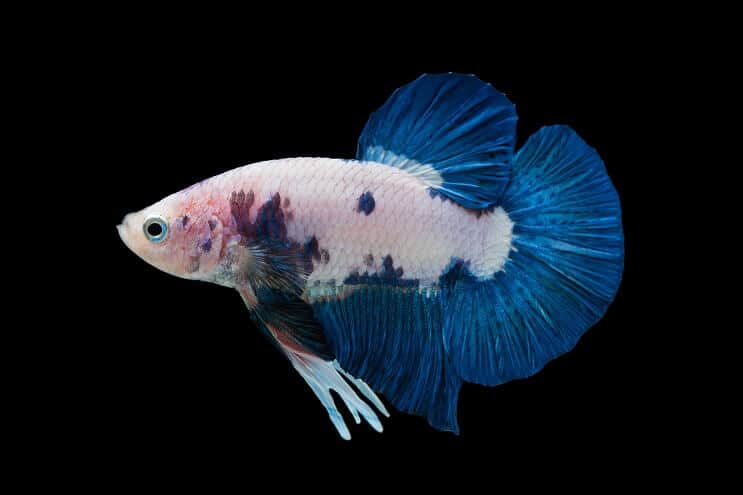
Marble Bettas are another very popular variation as they have an incredible color variation.
Their colors appear blotchy and irregular, often with a light pale solid body color with rich reds and blues creating a pattern.
Fins can show a marble-like pattern or solid translucent coloration.
The best thing about this type is that they develop their coloration over time.
Sometimes they will appear a certain color one week and the following week you will find a different one. However, as the fish ages, this ability will slow down.
Koi Betta
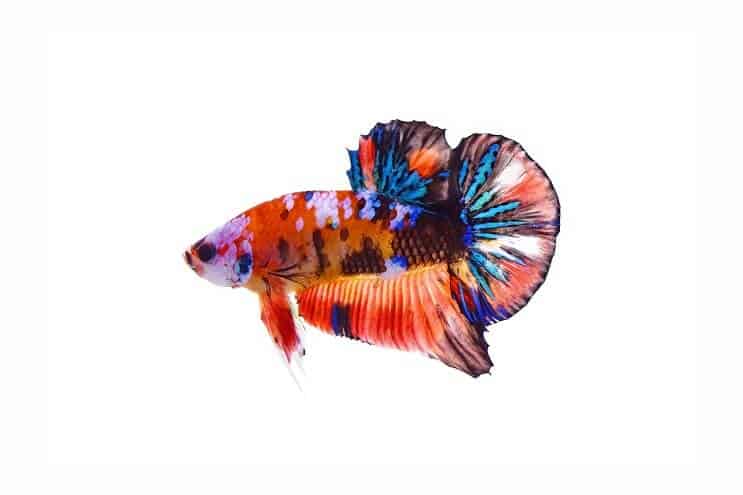
The koi betta is a variation of the Marble type, carefully selected through breeding. As the name suggests, this variation was bred to resemble the very popular Koi pond fish.
This is not a species found in the wild and was carefully bred over the years by aquarium hobbyists to preserve the most amazing characteristics and features.
There isn’t a distinct coloration for this type, their brightness, richness, and colors vary considerably.
Summary
These are small fish that are easily kept in 5-gallon tanks.
Also known as Siamese fighting fish, these aggressive small fish have the most striking tail variations, colors, and patterns.
Tail variation, colors, and patterns have been carefully and selectively bred over the years by experts and now there are hundreds of betta fish types.
Usually, in nature, they have duller colors, but the Betta destined for your aquarium will show the most exciting and striking combination.
Have you ever kept a Betta Fish – what is your favorite variation? Leave a comment in the section below…

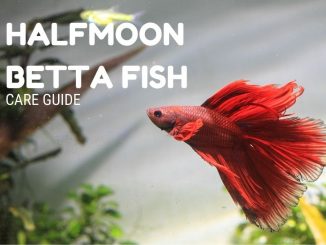
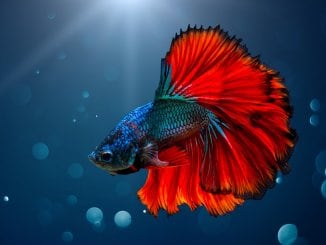

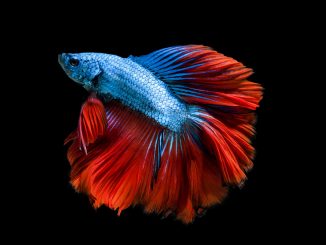

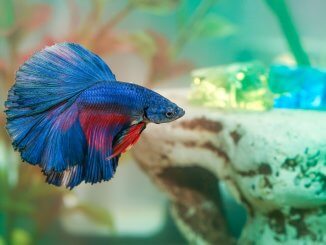
I love the article it is very informative. I was given 2 male Bettas when my neighbor from across the hall decided to move out. My daughter was excited and immediately changed their water without doing a lot of research first, one died the other is still kicking. I’ve trying to figure out what type the second (Aurora) is. Your article has helped me pin down the possibility of him being a Half-moon because he is way more aggressive than the new Betta which is a veil-tail
Hi Joseph, I’m glad you found the article helpful. Thanks for the comment, Robert
I think my betta is a female plakat, She has a small round tail, small sharp top fin and a longer bottom fin and she’s a metallic blue with a tint of red when viewed from a certain angle. This article somewhat makes me know more about the fish since other articles has no picture accompanying the type and description.
Could I have a rare rose petal betta?? I recently bought a couple of female betta fish…think my daughter chose a marble betta and has nicknamed mine burnt toast head since it’s face is much darker than its bright blue body haha
Do you think it could be a rose petal?
I have a delta tail betta, Aurora, he has a very unusual personality and appears to be a fighter. I mean this betta stands his ground when changing water he heads towards my hand gesturing ad challenging. He faints to the rear and runs after a while but mostly he shows no fear.
I have 2 female elephant ear bettas one with a white body and red fins and one that looks like a mermaid. But the first one which is Peaches is more of the alpha because she flares her gills at the other one named Ariel. So Ariel can’t eat any food. What should I do about this.
Hi Kaitlynn, do you have the option to put Ariel into another tank? I’d imagine she’ll be quite stressed at the flaring and not being able to eat in comfort. Alternatively, you can try adding more plants to allow each one to have their own territory. Many thanks, Robert
Absolutely the best fish. We have a red and purple crown tail and a sky blue mustard rose tail (both from petsmart). The crown tail is quite a lot bigger (we got them at the same time but I don’t know how old they are).
My daughter (3) really enjoys them as they are “friendly” and come to you and hover whenever you pay attention to them.
About how big will a Plakat get? I have one from Petco that was titled “Male, Red Platinum Dragon”. This is the first betta I have owned so looking for as much info I can find on them.
Hi Larry, Plakats grow to around 1.5 inches. Thanks, Robert
Hi Robert,
Thank you for the wonderful article. It is by far the most informative I have come across!
The first pet my husband and I ever owned together was a Crowntail named “Essex.” We got him in the late ‘90s, when the “Siamese Fighting Fish” craze first started (at least here in Charleston, SC). He made it through two moves and over four years with us and behaved more like a puppy than a fish!
I recently decided to get another and can’t believe the variety available these days. After a couple of weeks of looking, we found a beautiful fella with various shades of blue, leading to white fins. He was labeled a “Delta Tail” which and the folks at the pet store thought he had been mislabeled and was actually a more expensive variety. From the information you provided, I believe he is a marble delta with a big tail but am wondering if you might be able to provide a little more information on dorsal and/or caudal fin – specifically, the distance between them and the tail fin in Butterflies, Halfmoons, and Deltas. If you can help, I appreciate it in advance. If not, I am still a fan and appreciative of the knowledge you’ve already shared : ).
Hi! I have a young koi male betta. He’s quite the character. He doesn’t like any moving thing I his tank. He’s very teritorial. He loves his live plants and plastic plants, he’s in a 5 gallon tank. He’s what the breeder says a teenager. Not quite 1 years old and he has beautiful clolors
I used to have a dragonscale Betta named Ulysses. He lived with us for two years and died due to a silver bulge in his side that I have been researching
Nice article, thanks. But I find it disturbing that someone with your experience and influence advocates keeping Betta “easily in 5 gallon tanks”. Yes, on the page this page links to you express that 10 gallons is better. But there are 2 problems: 1) people don’t read all details. On this page you simply say 5 gallons suffices. 2) On the 5-gallon-page you say that 10 gallons is good, when even that is pretty small for such a large and remarkable fish. As you seem to know, in nature their inhabitat is much larger (and not small puddles). Please consider advocating better life for bettas through larger tanks (e.g. 25-30 gallons).
I currently have 1 male yellow w/light metalic blue stripe accent that is a “veilltail dragon”&he’s currently the only fish in my 30gallon long indonesian/hilstream biotype aquarium;after he attempted to treat some snail eggs that i knocked off the back panel as betta eggs..I’m considering maybe getting 2-3 female bettas to keep w/him as part of my comunity aqurium;it will consist of:loaches(catfish like&alge eating type),nano tetras&possiby a few whiptail catfish!I’m just not sure if my game plan will work!
I have a double tail purple male, he’s not true purple but still beautiful. I have him in a 10-gallon tank, do you recommend any plants in particular? I currently have a rosette sword and an anubius nana.
Where can I buy an imported betta, and how much is the price?
This is wonderful! I wish I could post a picture of him but I got a new friend today who is supposedly a black orchid male. He is so gorgeous! I signed up for the care guide. I had two bettas before but they weren’t in very good shape when I got them. My husband and I tried our best to save them but failed. I know they’re fighting fish but Fil seemed to have extreme anger issues. Two gallon tank in which we attempted to eliminate all reflection after seeing him slam himself at it a couple of times. He wouldn’t stop though. Sammi wasn’t in the same tank or even within sight and was pretty much the opposite of Fil in personality.
I haven’t settled on a name for this guy yet but I’m hoping to give him the best life possible!
Is a 5.5 gallon tank a good size or would he be happier in a bigger one?
I recently got a beta fish and it is a musterd gas Jetta. It is truly beautiful but could you give some tips on caring for them. He seems to be quite playful
*betta
I have a red and black delta tail male who will attack anything I put in the tank even my fingers! I really need help on tips to help me calm him down.
i have two bettas, a white red and blue male twintail halfmoon and a black, orange, red and cellophane female koi. alpha, my male, lives in a 20 gallon in my kitchen with my 4 neon tetras. (going to bump the school to 7 soon.) and my female, callie, lives in a 2.5 gallon in my room while her tank, a divided 10 gallon, is getting ready. yesterday i went to petsmart and saw a male pink elephant ear halfmoon betta, who i’m hoping i can go back and get once the tank is ready.
I think I have a young delta tail butterfly betta. His body is a few shades of blue and his fins started off with bits of blue and eventually turns into vibrant red then abruptly ends with almost translucent white. He’s only 10 or 11 weeks old so I’m really excited to see how he will turn out in the future.
I got a baby betta for Christmas this year and he is a beautiful creature. He has a pinkish/tan body with a bright vibrant tail. What breed do you think he is and do you have any specific tips for taking care of baby bettas?
Even as an experienced Betta keeper, I like to read these kind of articles to learn fun tips and trivia I might not have known before… I think this article was really well written and informative! I only wish there had been more pictures. The most common types were pictured, but the rare ones I hadn’t heard of I had to stop reading and google Images. Also, when saying “the females look completely different” may have been a nice place to insert the female’s pictures for comparison. Thank you for sharing your knowledge!
I have two bettas currently, though one is an infant and can’t be identified yet. I was wondering why the hobbyist across the street, a friend, kept asking me to sell him my adult betta. Note that I see he’s a green halfmoon with a dragon scale pattern I think I understand. Thanks for this super helpful article!
I have a male veiltail Betta and a plakat female. Them seem to have got together and I have young. What type would this be called please? Or as u have said that the veiltail is more prominent, so do they just get called veiltail?